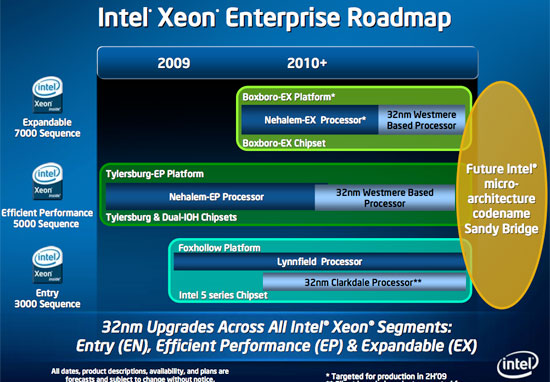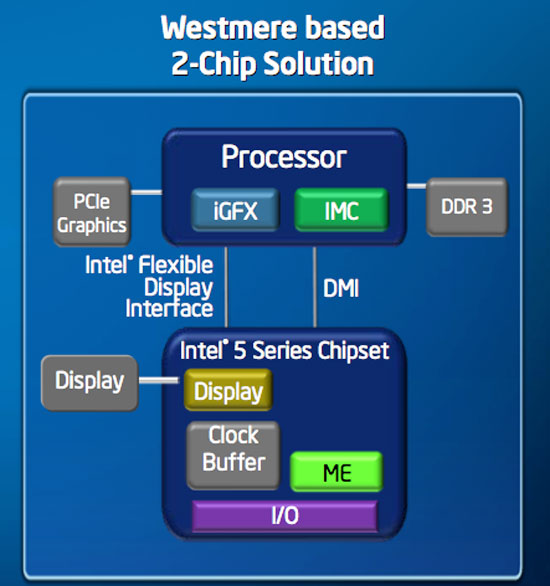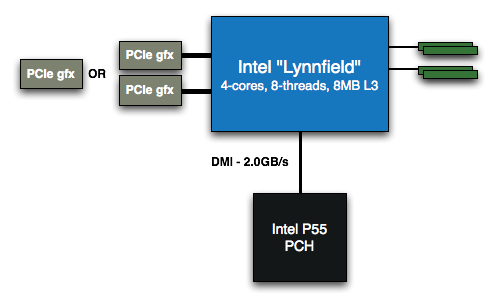Intel's 32nm Update: The Follow-on to Core i7 and More
by Anand Lal Shimpi on February 11, 2009 12:00 AM EST- Posted in
- CPUs
The Server Roadmap
Intel’s 32nm server roadmap is notably different from the desktop roadmap. Nehalem-EX will ship into the Xeon 7000 series as an 8-core, 16-thread part. It will eventually get replaced sometime in 2010 with a 32nm Westmere derivative.

We’ll see a 32nm six-core Westmere based processor in the Xeon 5000 series in 2010.
Finally Lynnfield and Clarkdale will be carried over to the entry level Xeon platforms at the end of this year and into 2010.
What About Chipsets?
Intel’s X58 chipset will remain the top dog through 2010. Chances are that we won’t see it replaced until the next tock with Sandy Bridge. Now that isn’t to say that the six-core 32nm Gulftown will work in existing X58 motherboards; while that would be nice, Intel does have a habit of forcing motherboard upgrades, we’ll have to wait and see.
The rest of the Nehalem/Westmere family will rely on Intel’s upcoming P55 chipset:

Originally both Lynnfield and Havendale were to have an on-package PCIe controller, I’m not sure if that has changed with the Havendale cancellation but I see no reason for it to have. In which case a Lynnfield system will still look like this:











64 Comments
View All Comments
Jovec - Wednesday, February 11, 2009 - link
Take a look at your Program Menu and tell me what apps today that are not multithreaded would receive serious benefit from being multithreaded? Besides gaming? Single-thread apps do receive benefits from multiple cores in typical usage scenarios because they can be run on a (semi) dedicated core and not interfere with other apps.philosofool - Wednesday, February 11, 2009 - link
Interesting thought. I'm hoping that with the mainstreaming of the dual core, multi-threaded apps become more common and that the single to dual jump turns out to be the biggest leap. But it's really just a hope on my part, don't know if it will happen.Isn't there a multitasking advantage with 4 core machines? Also, once we start ripping 720 and 1080p files, 6 cores is gonna be hot.
7Enigma - Thursday, February 12, 2009 - link
There are definite multitasking advantages with quadcore if you are heavily multitasking (i'd argue tri-core is probably used more effectively currently than that final 4th core). Single to dual, however, was a much greater difference for multitasking on the whole.I just don't see the quad-hex jump being more beneficial than quad-juicedquad in this case.
strikeback03 - Wednesday, February 11, 2009 - link
Yeah, can't say I'm real happy about the lack of a 32nm quad-core for 1366. If my motherboard supported Penryn I'd probably just buy one of those cheap, getting an SSD, and waiting for Sandy Bridge. Since it doesn't, the decision is more difficult. Probably depends how much business I get this year.Pakman333 - Wednesday, February 11, 2009 - link
DailyTech says Lynnfield will come in Q3? Hopefully it will have ECC support.iwodo - Wednesday, February 11, 2009 - link
SSE 4.2 doesn't bring much useful performance to consumers.There is no Dual Core Westmere or Nehalem. Not without Intel Sh*test Graphics On Earth.
No wonder why Unreal Dev and Valve are complaining that Intel GFX is basically Toxic....
And i cant understand why Anand is excited, Macbook with Intel Graphics all over again?
And Just before anyone who say Intel Gfx will improve. Please refer to history, from G965 to their X series are so full of Marketing BS.... And never did they delivery what they promised.
ssj4Gogeta - Wednesday, February 11, 2009 - link
noone's forcing you to use G45. you can still use discrete gfx cards.Daemyion - Wednesday, February 11, 2009 - link
Actually, they fully delivered on the marketing. It's just that when Nvidia/ATI delivered products in the same space Intels product looked rubbish. There is nothing wrong with the G45 other than it not being an 9400 or a 790GX.Spoelie - Wednesday, February 11, 2009 - link
wasn't yonah the first processor out at the 65nm node? if so intel did perform the same stunt earlier, only at 45nm did they not release a laptop version first.IntelUser2000 - Wednesday, February 11, 2009 - link
No, the Pentium 955XE based on Pentium D was.